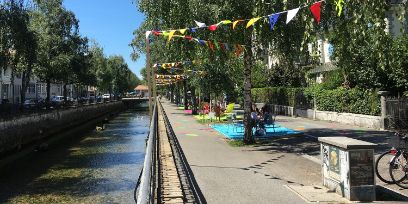- Story
«Planting trees will not stop climate change»
19.08.2022 There are some good projects under way in Swiss cities in response to climate change, says William Fuhrer, professor of urban development and mobility and head of BFH’s Dencity area of expertise. However, it will take considerable effort to deal with the causes. “To do that, processes in spatial planning would have to be simplified and speeded up,” he believes.

Mr Fuhrer, do you personally suffer from the heat?
William Fuhrer: Actually no, I love it when it’s warm. But of course, I also make arrangements to keep it bearable. We are very careful to shut out the sun in our top-floor flat in Bern during the day and let the cool air in at night. And in summer, I spend a lot of time down by the cool River Aare or in the Old Town: it’s not quite so hot in the shady alleyways.
Hot spells are becoming more frequent due to climate change. Does this make your work as an urban developer more difficult?
Yes. When developing our cities, we have to cater to the needs of business, the environment and the population – and do so in such a way that future generations can also live well with our solutions. Here we must also follow the guidance of the UN’s Sustainable Development Goals within the framework of the 2030 Agenda. It comprises a whole lot of different interests and expectations. And now we have to factor in the effects of climate change too.
What does that mean exactly?
Take transport as an example: for businesses, city centres must be easily accessible by motorised traffic, and residents also want to be able to park in front of their homes. At the same time, people are bothered by the noise. Roads make up around 23 percent of our developed areas. And now, in summer, concrete-covered, asphalt surfaces are increasingly turning into heat islands because they store energy, which boosts the surface temperature.
So parts of these areas should be used differently?
Yes. As the climate changes, we need to provide more recreational areas and green spaces in cities, with trees that provide shade, to make it possible for people to spend more time outdoors. Sealed ground surfaces are also problematic in many cities today, as there is virtually nowhere for water to accumulate over long periods of time. We catch it and channel it straight into the drainage network. As a result, the ground beneath our cities has completely dried out. Based on the “sponge city” principle, however, we should keep any water that falls in the cities as long as possible. The resulting humidity would, among other things, improve the urban climate during hot spells.
What successful climate change mitigation projects exist in Swiss cities?
There have long been avenues of trees in many places. In Bern, for example, the streets are lined with huge plane trees. In Biel, the many trees along Unterer Quai already provide shade. In recent years, though, especially when redesigning public squares, we have missed the opportunity to bring in a bit of nature. They are often dominated by concrete areas. A prime example of such a missed opportunity is the Place de l’Esplanade in Biel.
How could this happen?
It’s probably a reflection of the zeitgeist of recent years, in which clear-cut geometric shapes played an important role. Then there is the maintenance aspect: it causes extra work if you have to mow the grass or care for a tree. My impression is that in Switzerland, you get the occasional slight adaptation to the increasingly frequent periods of heat – here a few trees in a rectangle, there a cloud of mist, as in Zurich, for example. But nature needs more space to develop effectively. Actually, we should see it as a necessity to welcome as much nature as possible in the cities.
Where is there an example of this?
On the Unterer Quai in Biel, which I mentioned earlier, they are trying to create something exactly like this. The idea is to get façade greening to extend across several houses; the ground is being unsealed and covered with gravel. Alongside natural paths, bushes and shrubs are being planted between the trees. We presented a competition-winning project that proposed this at BFH’s urban laboratory in Biel and discussed it with the local public. It offers a promising starting point: the project development phase will run until 2023, during which time residents or business owners can signal their needs. But there is a good chance that it will turn into a comprehensive adaptation project to be realised by 2028 after a popular vote.
As an urban developer, what can you do about the causes of climate change?
Within the context of nationwide spatial planning, we have always implemented the concept of decentralised concentration in Switzerland. In other words, we have many communities and agglomeration centres all over the country where people live and sleep, but do not work or shop. An urban development strategy that combats the causes of climate change would have to ensure that these many centres become self-sufficient – that people have the opportunity to live, work, go to school and shop there. This would significantly minimise passenger and goods traffic.
Is that realistic?
Difficult to say. It would require, for example, persuading a major distributor to open a branch in such a location, which they might not do if it weren’t profitable for them. To bring about such fundamental changes, we have to overcome a whole lot of different individual interests. But there are other good approaches to urban development too.
Such as?
Urban mining, i.e. the use of existing resources to further develop a city in a densified way. In other words, before you build a new house, you should ask yourself whether you could upgrade the old one instead. If you do decide to build, you should reuse materials and building components that are available in the city. A good example of this can be found on Bächliweg in Bern. There, existing industrial buildings were converted into flats, even though the floor plans were not at all suitable for this. So instead of creating the classic 3.5, 4.5 or 5.5 room flats, they made it into a huge shared house with communal kitchens and an integrated self-service shop. So at the same time, it enabled new lifestyles to develop.
Can a project like this start a new trend?
Yes. The more such examples there are, the more people will start copying them. After all, most of us are aware that we have to do something. Planting a few trees will not stop climate change. What’s more, we have a good political framework in Switzerland, with subsidies for the renovation of existing buildings and for sustainable mobility. But we could still do with a little more flexibility in urban development. It takes too long from the planning of a project to its realisation: the associated processes need speeding up.
